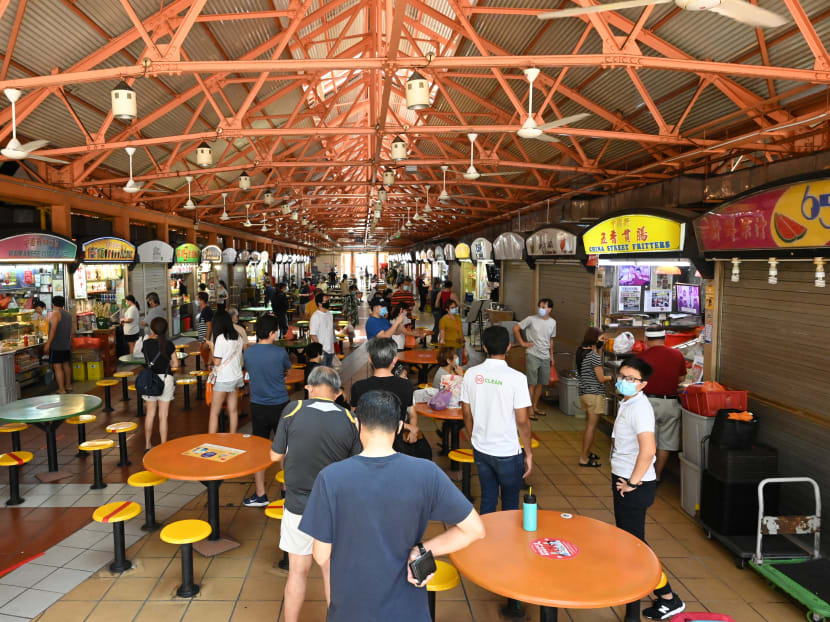Singapore hawker culture a step closer to being on Unesco intangible cultural heritage list
SINGAPORE — Hawker culture in Singapore stands a good chance of being inscribed on The United Nations Educational, Scientific and Cultural Organization (Unesco)'s Representative List of the Intangible Cultural Heritage of Humanity, after an evaluation body from the agency announced its recommendation on Monday (Nov 16).

People, wearing face masks as a preventive measure against the spread of Covid-19, queue to buy food at a hawker centre in Singapore on May 14, 2020.
SINGAPORE — Hawker culture in Singapore stands a good chance of being inscribed on The United Nations Educational, Scientific and Cultural Organization (Unesco)'s Representative List of the Intangible Cultural Heritage of Humanity, after an evaluation body from the agency announced its recommendation on Monday (Nov 16).
Singapore's Unesco submission fulfilled all the criteria required for inscription, the evaluation found. The 12-member evaluation body was appointed by an intergovernmental committee, which will announce the final decision in mid-December.
In the recommendation, it was noted that hawker culture is "an integral way of life in Singapore" and provides a "sense of identity and continuity for people across the generations".
Hawker culture in Singapore is also an example of how intangible cultural heritage can thrive in a highly urbanised environment, the evaluation body said.
National Heritage Board (NHB) chief executive officer (CEO) Chang Hwee Nee said that the agency has seen overwhelming support from Singaporeans since Singapore’s nomination was made in August 2018.
"We hope the successful inscription of hawker culture would further raise awareness and appreciation among Singaporeans of the importance of intangible cultural heritage in our daily lives, and continue to promote dialogues among our communities," she said.
Mr Tan Meng Dui, CEO of the National Environment Agency (NEA), said that hawkers are central to Singapore's hawker culture and NEA "remains steadfast" in its efforts to attract new entrants to the trade. It will also partner hawkers and stakeholders to sustain and strengthen hawker culture.
"A successful inscription in December will be the finest form of recognition to all our hawkers, past and present," he said.
Unesco received 42 proposals, of which 25 have been recommended for inscription. Besides hawker culture, the Yeondeunghoe lantern lighting festival in South Korea, watchmaking craftsmanship nominated by Switzerland and France, and beekeeping culture in Poland were also recommended.
The decision will be announced at the 15th session of the Intergovernmental Committee (IGC) held online from Dec 14 to Dec 19.
WHAT IS INTANGIBLE CULTURAL HERITAGE?
Unesco defines tangible cultural heritage as traditions and practices that are “living heritage”.
It emphasises the wealth of knowledge and skills that is transmitted through such traditions from one generation to the next.
The Representative List of the Intangible Cultural Heritage of Humanity was started in 2008 and recognises these cultural practices as part of the diverse cultures of the world. The list currently comprises 463 items, among them Chinese shadow puppetry, French cuisine, the Indonesian angklung, traditional Japanese cuisine, the making and sharing of kimchi and yoga from India.
Malaysia has three items on the list — the ancient theatre art form of Mak Yong, silat and dondang sayang.
WHAT AN INSCRIPTION WILL MEAN FOR HAWKER CULTURE
Hawker culture is one of the most recognisable and acknowledged representations of Singapore’s multicultural culture and identity, said Singapore’s National Heritage Board (NHB).
Hawker culture is shared by everyone living in Singapore, regardless of age, ethnicity and nationality. It is not a “dying” culture, said Dr Wong King Yin, a marketing and tourism expert from Nanyang Technological University’s Nanyang Business School.
“It’s still actively practised by everyone living in Singapore and will be passed on to the future generations. The inclusivity and continuity of the hawker culture makes it a heritage item,” she said.
“The hawker culture is an important part of our heritage, because it gives everyone living in Singapore a sense of belonging and identity. It also helps to build social cohesion.”
Being inscribed on the list does not mean that it is an authentic or correct form of the cultural practice, according to Unesco. It also does not indicate that hawker culture is unique to Singapore or that the way it is practised here is superior to others.
Associate Professor Kelvin Low from the National University of Singapore's department of sociology said that if hawker culture is inscribed in the intangible cultural heritage list, more attention and effort can be devoted to safeguarding it.
"Further traction, visibility, and awareness may be garnered towards adding on to extent efforts in ensuring that such a pertinent component of the country’s culinary history and heritage is paid further attention and resources being devoted towards its sustenance and posterity," he said.
Unesco recognition of practices, forms and tradition is "one of the key elements that drive forward further and future efforts in collective endeavours to both comprehend and acknowledge the role of heritage for generations past, present and future", he added.
Whether or not the inscription is successful, the nomination of hawker culture for Unesco's list already reflects Singapore’s commitment to ensuring that it is sustainable for future generations, as a living heritage, the NHB spokesperson said.
Over the years, the Government has implemented programmes to help sustain the hawker trade by attracting new entrants and supporting existing stallholders. These programmes have seen encouraging take-ups, said the spokesperson. CNA
For more stories like this, visit cna.asia









